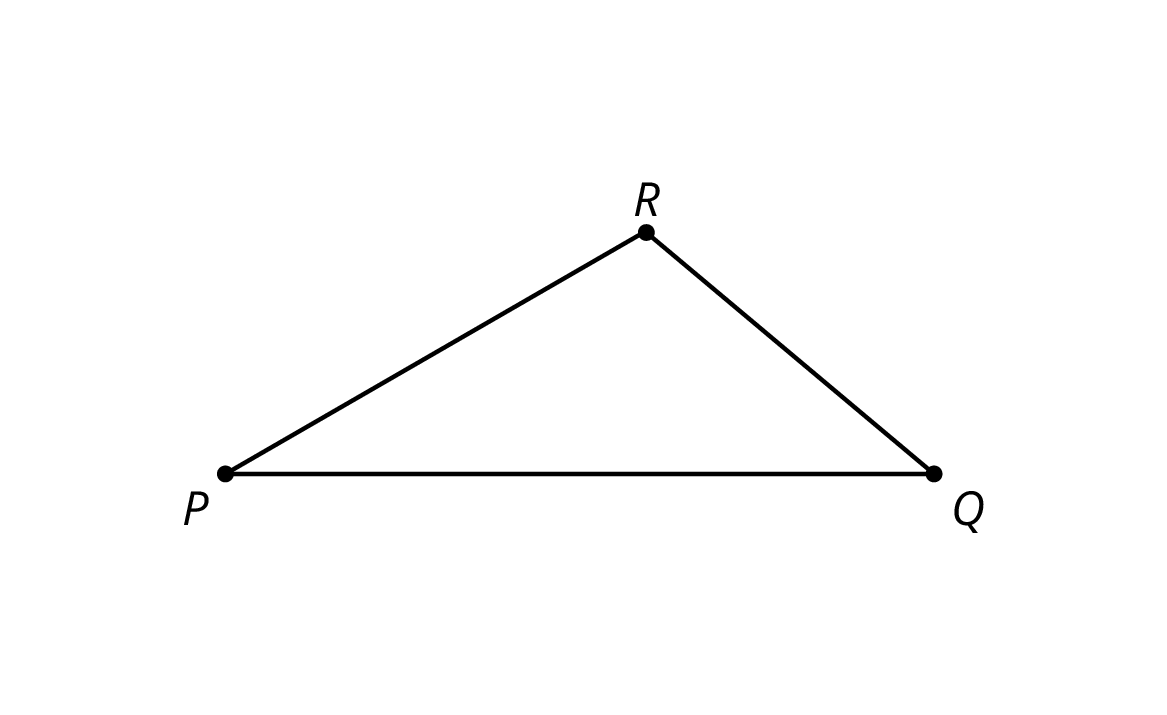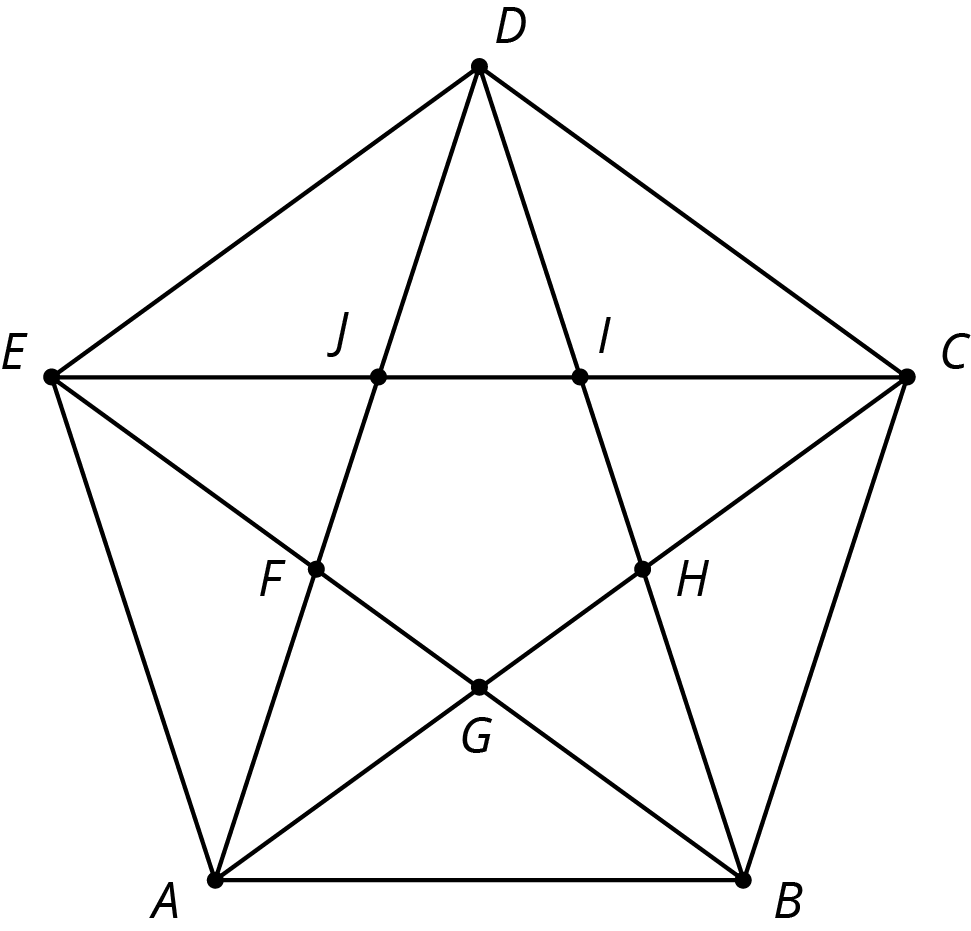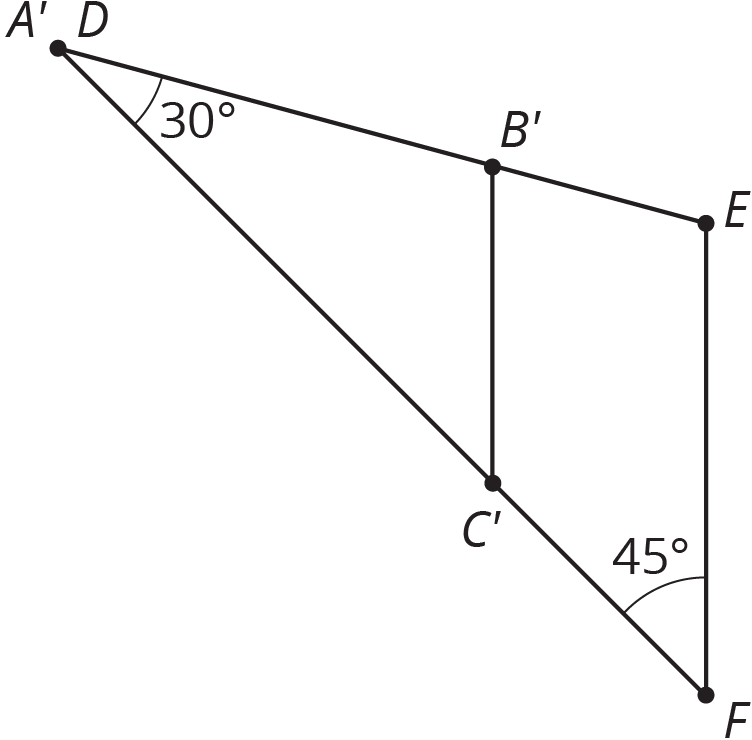Lesson 8
Similar Triangles
8.1: Equivalent Expressions (5 minutes)
Warm-up
This warm-up prompts students to use what they know about operations to create related expressions. While many warm-ups in the unit encourage students to work mentally and verbally, students will write their responses to this prompt. Since many different responses are possible, the task is accessible to all students and provides an opportunity to hear how each student reasons about the operations.
Launch
Arrange students in groups of 2. Display problem. Give students 1 minute of quiet think time and ask them to give a signal when they have three expressions. Follow with a 1 minute partner discussion and then a whole-class discussion.
Student Facing
Create three different expressions that are each equal to 20. Each expression should include only these three numbers: 4, -2, and 10.
Student Response
For access, consult one of our IM Certified Partners.
Anticipated Misconceptions
If students only rely on the associative and commutative properties, suggest that they try to include at least one expression containing parentheses.
Activity Synthesis
Ask selected students to share their expressions. Record and display their responses for all to see. Ask students if or how the factors in the problem impacted their strategy. To involve more students in the conversation, consider asking:
- “Did anyone have a similar expression?”
- “Did anyone have a different expression related to this one?”
- “Do you agree or disagree? Why?”
8.2: Making Pasta Angles and Triangles (30 minutes)
Activity
In this activity, students create triangles with given angles and compare them to classmates’ triangles to see that they are not necessarily congruent, but they are similar.
Each angle measure in a triangle imposes a constraint and students are examining in this activity how many constraints there are in similar triangles. There are only two. This makes sense since we can place one side of the triangle and then the triangle is determined by the length of that side and the two angles made with that side. (Note: the length of that side can be scaled with an appropriate dilation to give any particular similar triangle with these angles.)
Watch for how students deal with measurement error. Remind students who are looking for proportional side lengths in similar triangles that they may not be exactly proportional. Also, students may find that their rounded angle measures do not add up to \(180^\circ\). Remind them that the measurements are only approximate.
Launch
Tell students that they are going to build triangles using pasta and some of their given angles. Then they will find classmates who used the same angle(s) and compare their triangles. Tell them that they will need to move around the classroom to identify partners who use the same angle(s). For large classrooms, consider asking students to find three matching partners instead of two. Demonstrate how to measure angles in a pasta triangle.

In this picture, the approximate angle measures are \(90^\circ\), \(50^\circ\), and \(40^\circ\). Tell students that they can trace their angle(s) on the sheet of paper they are going to use to build their pasta triangle.
Provide students with 1 strip of 3 angles (A, B, and C) pre-cut from the blackline master. Each student should also have access to tape, and extra paper to tape their triangles to. Finally, each student will need a ruler (which should be available in their geometry toolkits).
Pause students after they have made and compared triangles with one angle (first problem) and three angles (second problem). Make sure that students have found some non-similar triangles on the first problem and similar triangles for the second. Consider doing a gallery walk to see how the first sets of triangles differ and how the second sets of triangles are alike. Then have students work on the third problem.
Supports accessibility for: Visual-spatial processing; Conceptual processing
Design Principle(s): Support sense-making; Maximize meta-awareness
Student Facing
Your teacher will give you some dried pasta and a set of angles.
- Create a triangle using three pieces of pasta and angle \(A\). Your triangle must include the angle you were given, but you are otherwise free to make any triangle you like. Tape your pasta triangle to a sheet of paper so it won’t move.
- After you have created your triangle, measure each side length with a ruler and record the length on the paper next to the side. Then measure the angles to the nearest 5 degrees using a protractor and record these measurements on your paper.
-
Find two others in the room who have the same angle \(A\) and compare your triangles. What is the same? What is different? Are the triangles congruent? Similar?
-
How did you decide if they were or were not congruent or similar?
- Now use more pasta and angles \(A\), \(B\), and \(C\) to create another triangle. Tape this pasta triangle on a separate sheet of paper.
- After you have created your triangle, measure each side length with a ruler and record the length on the paper next to the side. Then measure the angles to the nearest 5 degrees using a protractor and record these measurements on your paper.
-
Find two others in the room who used your same angles and compare your triangles. What is the same? What is different? Are the triangles congruent? Similar?
-
How did you decide if they were or were not congruent or similar?
-
Here is triangle \(PQR\). Break a new piece of pasta, different in length than segment \(PQ\).

- Tape the piece of pasta so that it lays on top of line \(PQ\) with one end of the pasta at \(P\) (if it does not fit on the page, break it further). Label the other end of the piece of pasta \(S\).
- Tape a full piece of pasta, with one end at \(S\), making an angle congruent to \(\angle PQR\).
- Tape a full piece of pasta on top of line \(PR\) with one end of the pasta at \(P\). Call the point where the two full pieces of pasta meet \(T\).
-
Is your new pasta triangle \(PST\) similar to \(\triangle PQR\)? Explain your reasoning.
-
If your broken piece of pasta were a different length, would the pasta triangle still be similar to \(\triangle PQR\)? Explain your reasoning.
Student Response
For access, consult one of our IM Certified Partners.
Student Facing
Are you ready for more?
Quadrilaterals \(ABCD\) and \(EFGH\) have four angles measuring \(240^\circ\), \(40^\circ\), \(40^\circ\), and \(40^\circ\). Do \(ABCD\) and \(EFGH\) have to be similar?
Student Response
For access, consult one of our IM Certified Partners.
Anticipated Misconceptions
Students may need a reminder that the sum of angles in any triangle is 180 degrees.
Activity Synthesis
Ask students if they needed all three angle measurements to build a triangle in the second problem. Some students may notice that it was not necessary: once they knew two angles, that was enough to build the pasta triangle, the third angle automatically being the right measure. Other students may find that having the third angle was helpful to get better accuracy for all three angle measures. Ask students how this relates to their findings on the last question: the last question shows that two shared angle measures would be enough to guarantee that two triangles are similar. This makes sense because the sum of the angle measures in a triangle is 180 degrees so triangles that share two pairs of congruent angles actually share three pairs of congruent angles.
Some important discussion questions include
- “Did your angles in the triangle always add up to 180 degrees?” (Answers may vary for the first triangles because the angles were rounded to the nearest 5 degrees and the rounding can influence the sum of the angles.)
- “How did you decide whether or not the sides of your triangle were proportional to other triangles?” (Answers vary, the key being that measurement error means that quotients computed from measured side lengths may not be exactly equal even if the triangles are similar.)
- “How did you check whether or not your triangle was similar to another?” (Answers should include aligning an angle and then dilating when the triangles were similar, and observing that the angles were different or the sides were not proportional when they were not similar.)
A big conclusion from this activity is that if triangles share two pair of congruent angles then they are similar. For the quadrilaterals studied in the previous activity, there was another instance where a pair of congruent angles was enough to decide that quadrilaterals are similar, namely rhombuses. But the triangle result is more surprising because there are three side lengths and no restrictions are made on these.
8.3: Similar Figures in a Regular Pentagon (10 minutes)
Optional activity
This activity presents a complex figure with many triangles and asks students to find triangles similar to a given triangle. From the previous activity, students know that finding two pair of congruent angles is sufficient to show similarity. Students may also measure all three angles and check that they are congruent. In addition to using angle measures, students can describe transformations that take one triangle to another.
Monitor for students who use these methods to show that their chosen triangles are similar to triangle \(DJI\):
- finding a sequence of translations, rotations, reflections, and dilations
- checking that two (or three) corresponding angles are congruent
Select students who use these methods and invite them to present during the discussion.
Launch
Tell students that they may use anything in their geometry toolkits as well as a copy of triangle \(DJI\) to find triangles similar to it.
Supports accessibility for: Visual-spatial processing
Design Principle(s): Maximize meta-awareness
Student Facing
-
This diagram has several triangles that are similar to triangle \(DJI\).

- Three different scale factors were used to make triangles similar to \(DJI\). In the diagram, find at least one triangle of each size that is similar to \(DJI\).
- Explain how you know each of these three triangles is similar to \(DJI\).
- Find a triangle in the diagram that is not similar to \(DJI\).
Student Response
For access, consult one of our IM Certified Partners.
Student Facing
Are you ready for more?
Figure out how to draw some more lines in the pentagon diagram to make more triangles similar to \(DJI\).
Student Response
For access, consult one of our IM Certified Partners.
Anticipated Misconceptions
If students eyeball the triangles in predicting similar triangles, make sure they justify their decisions by including specific measurements.
Activity Synthesis
Invite selected students to share some of the triangles they found and explain how they determined the triangles to be similar. Sequence them so students who used rigid transformations and dilations go first, followed by those who use angle measures. Concluding that two triangles are similar using the angle criterion from the previous task is a quick, efficient argument. On the other hand, finding explicit transformations and dilations taking one triangle to another provides a more tactile, concrete experience. Both are important methods and students can choose based on their own personal comfort and the nature of the problem at hand.
Make a list of different ways to show that two triangles are similar, including:
- using transformations (cutting out the triangle and placing it appropriately)
- finding two congruent corresponding angles in the triangles
- finding three congruent corresponding angles in the triangles
Among those triangles that are not similar to \(DJI\), ask if some of these may be similar to each other.
Lesson Synthesis
Lesson Synthesis
This lesson focuses on how the angle measures influence the shape of a triangle. If a triangle has a 50 degree angle, what does that tell me about its shape? Could it be isosceles? (yes, two 50 degree angles and an 80 degree angle). Could it fail to be isosceles? (yes, one 50 degree angle, one 20 degree angle, and one 110 degree angle). Are all triangles with a 50 degree angle similar? (no, because the other two pairs of angles could be different).

8.4: Cool-down - Applying Angle-Angle Similarity (5 minutes)
Cool-Down
For access, consult one of our IM Certified Partners.
Student Lesson Summary
Student Facing
We learned earlier that two polygons are similar when there is a sequence of translations, rotations, reflections, and dilations taking one polygon to the other. When the polygons are triangles, we only need to check that that both triangles have two corresponding angles to show they are similar—can you tell why?
Here is an example. Triangle \(ABC\) and triangle \(DEF\) each have a 30 degree angle and a 45 degree angle.

We can translate \(A\) to \(D\) and then rotate so that the two 30 degree angles are aligned, giving this picture:
